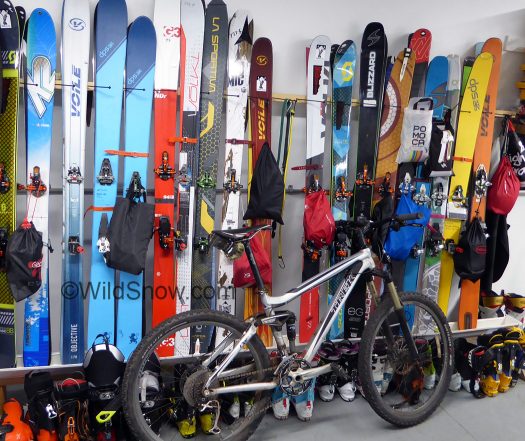Aaron Mattix
The reward of exploring untracked winter terrain has me daydreaming of snow in the midst of summer — and I’m not the only one. The uphill skiing scene has generated enough mass and momentum to merit a front page article in our local paper this past winter. A full moon Friday night at the warming hut on top of the mountain is as hopping as any downtown bar, the side country is webbed with skin tracks, and powder stashes are now about as secret as hacked internet passwords. Summer is short.
But it is bike season, so I’m thinking about that too. Some comparative thoughts:
Hang around in any gear-driven sport long enough, and you will get the hankering to upgrade. As proficiency develops, so does appreciation of gear function. My mountain biking background goes back about twenty years, my skiing only two. As my interest in skiing and ski-touring has grown, mountain biking has been my frame of reference for understanding the art of climbing up and sliding around on sticks.
The divisions of culture are broadly similar: the skinny and lycra-clad xc/skimo crowd; kitted-out DH racers, voluminously baggy free riders, tight pants for the urban scene. The dawn of the skimo racing scene in the US roughly coincides with the same period the weight weenie wars were fading off the mountain bike scene like purple anodizing, as the star of enduro rose. The Europhilic roots of bright colors and and lycra present in the skimo scene were a natural graft for the displaced XC mountain bike crowd, who were already conditioned to choose uphill performance over downhill control.
Despite the rise of ski touring, the predominance of the lift and the resort-based experience dominates ski culture in general. Conversely, in mountain biking the assumed paradigm is that you propel yourself up, down, and across wherever the trail leads. Unlike skiing, lift-accessed bike riding is a more specialized domain, requiring a separate set of equipment; often presumed to be limited to those with an advanced skill set.
Equipment expectations run somewhat backwards between the two sports. The standard expected performance envelope of ski gear is that of a 8” travel dual-crown dh/park bike (Santa Cruz V10, Kona Entourage) in the mountain bike world. The 5” trail bike (Santa Cruz 5010, Ibis Mojo) finds its counterpart in the classic tech binding system, with popularity reversed. Sound like Greek to you non bikers? Put simply, much like tech bindings, you can ride a 5” travel trail bike at the resort, but doing so requires a careful and conscientious touch and limits your access to rowdy terrain unless you’re deliberately compromising. Likewise, taking a DH mountain bike on a regular trail ride makes about as much sense as setting out on a Colorado forest hut trip with a pair of Scarpa Freedom boots, Duke bindings, and 120 cm waisted freeride planks.
In ski touring, clothing is just as much a part of the technical gear aspect as the hardware of boots, bindings, and skis. Go ski touring in your normal street clothes, and it’s not much of a stretch to say you could be putting your life at risk. Go mountain biking in Dickies shorts and your favorite t-shirt, and you might get a little sweaty, but you’ll still have a good time without worrying about the threat of hypothermia.
This makes the biking equipment checklist much shorter and less stressful than gearing up for a day of skinning laps. Sure, by mid-winter the checklist becomes second nature — but every time I switch up the routine to go mountain biking instead of skiing, I am astonished at how easy it is to get ready. Especially if you are rocking flat pedals, the transition from arriving at the trailhead to riding down the trail is far less of a hassle than stuffing your feet into plastic boots, remembering you forgot to put on your skins, doing the special binding dance, and knocking down your poles half a dozen times.
It appears to me as though the development of “Tech 2.0,” and the growth of skimo racing is parallel to to the recent learning curve mountain bike companies went through sorting out suspension design, and the subsequent development of enduro racing. As modernized tech bindings become more widely available, and consumers become more aware of their capabilities, and limitations, ski touring becomes a natural off-season compliment to the mountain biking experience that is becoming the growing normal for many mountain towns. While this could mean that your favorite secret stashes aren’t so secret any more, a larger user group also means more clout for access issues, and a volunteer base. Will ski route glading projects become the equivalent of bike trail work days? Could the two be combined?
(Guest blogger Aaron Mattix grew up in Kansas and wrote a report on snowboarding in seventh grade. His first time to attempt snowboarding was in 2012, and soon switched over to skis for backcountry exploration near his home in Rifle, CO. His skill level is “occasionally makes complete runs without falling.” In the summer, he owns and operates Gumption Trail Works, building mountain bike singletrack and the occasional sweet jump.)
Beyond our regular guest bloggers who have their own profiles, some of our one-timers end up being categorized under this generic profile. Once they do a few posts, we build a category. In any case, we sure appreciate ALL the WildSnow guest bloggers!

